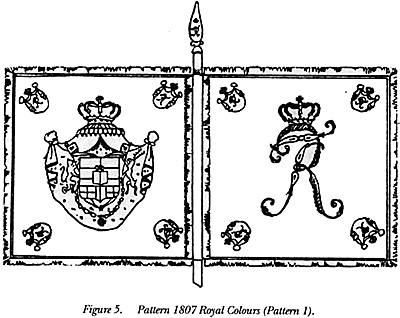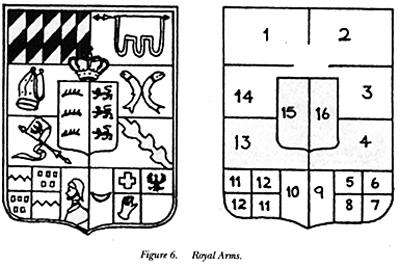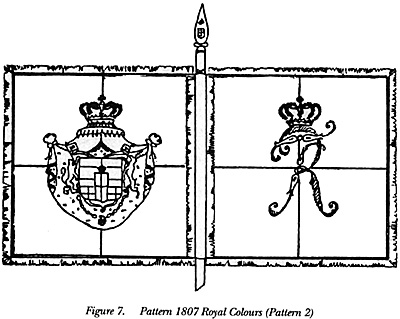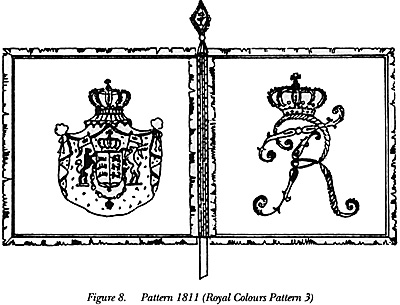Wuerttemberg became a Kingdom on 1st January 1806 and on the 25th of the month, 6 new infantry regiments were raised by adding a second battalion to the existing musketeer battalions. The first battalions of these new regiments retained the colours already presented to them, and described above. The newly raised second battalions, however, were presented with the first of a series of patterns of Royal Colours.
Pattern 1
Koenigreich Falmenmuster 1807 - Muster I (Pattern 1807 Royal Colours (Pattern 1)) are illustrated at Figure 5. They were double sided silk as before but slightly smaller than the Pattern 1798 Ducal Colours being only 125cm x 125cm but retaining the 6cm fringe.
 Figure 5. Pattern 1807 Royal Colours (Pattern 1)
Figure 5. Pattern 1807 Royal Colours (Pattern 1)
Obverse: FR cypher and unlined crown embroidered in natural colours. Corner devices similar to before but now with the FR cypber.
Reverse: The Royal Arms flanked by a yellow lion and stag holding Reichssturmfahnen.
The finial was a gilt spear point bearing the cypher and central shield from the arms, on obverse and reverse respectively.
The distribution of the Pattern 1807 Royal Colours (Pattern 1) was as follows.
- Infanterie-Regiment von Phull, 2. Battailon: 2 Lemon yellow.
Infanterie-Regiment Herzog Wilhelm, 2. Battailon: 2 Ponceau Red.
Infanterie-Regiment von Camerer, 2. Battailon: 2 Turquoise.
Infanterie-Regiment von Romig, 2. Battailon: 2 Rose red.
Infanterie-Regiment von Lilienberg, 2. Battailon: 2 Light blue.
Infanterie-Regiment Kronprinz, 2. Battailon: 2 Orange.
These colours, together with the Ducal and Electoral presentations, which continued in use by first battalions, were those carried through the Russian campaign and up to 1813, in some cases beyond. On 5th November 1812, the colours taken by the regiments to Russia were removed from their staffs. The staffs were burnt and the silks brought home to Wuerttemberg wound round the bodies of the men.
 Figure 6. Royal Arms.
Figure 6. Royal Arms.
The Royal Arms were similar to those of the Electorate and are illustrated at Figure 6; Legend as follows.
- 1. Teck.
2. Red religious banner on a gold field: Tuebingen.
3. Moempelgard.
4. Justingen.
5. Hall.
6. Hall.
7. Hall.
8. Hall.
9. Boenningheim.
10. Heidenheim.
11. Franken.
12. Limpurg.
13. Groeningen.
14. Ellwangen.
15. Wuerttemberg.
16. Wuerttemberg.
Pattern 2
On 10 October 1806, the Fuesilier-Bataillon was raised, soon increased to a regiment by the addition of a second battalion in January of the subsequent year. On 17th September 1809, from the Depot-Bataillone established injunc, Infanterie-Regiment von Scharfenstein was raised.
These units were presented with Koenigreich Fahnenmuster 1807 - Muster 2 (Pattern 1807 Royal Colours (Pattern 2) on a scale of 2 per battalion.
These colours were essentially the same design as the Pattern 1807 Royal Colours (Pattern 1), the principal differences being that they were in two colours arranged quarterly and that they lacked the corner devices. An illustration is at Figure 7.
 Figure 7. Pattern 1807 Royal Colours (Pattern 2)
Figure 7. Pattern 1807 Royal Colours (Pattern 2)
Distribution was as follows.
Fuesilier-Bataillon: 2 blue/red quarterly, blue in the upper staff and lower fly.
Fuesilier-Regiment 2. Bataillon: 2 as above.
Infanterie-Regiment von Scharffenstein: 4 blue/yellow quarterly, blue as above.
Pattern 3
A Royal Decree of 26th May 1811 prescribed new Royal Colours to replace existing Ducal and Electoral emblems still in use by first battalions. These were to be like the vexilla standards already presented to the Garde zu Pferde. They were, however, still not ready by the Autumn of the year and, as already described, the regiments participating in the Russian campaign carried their old colours.
The Koenigreich Fahnenmuster 1811, Muster 3 (Pattern 1811 Royal Colours (Pattern 3) is illustrated at Figure 8. These coloure were 125cm x 125cm with a 7cm yellow fringe on all four edges and both sides as before. They were attached to the staff, which was 308cm long coloured black over dark brown in equal proportions, by three rows of 26 gilt nails.
 Figure 8. Pattern 1811 (Royal Colours Pattern 3)
Figure 8. Pattern 1811 (Royal Colours Pattern 3)
Obverse: The crowned Royal Cypher FR.
Reverse: A heraldic cloak bearing a crowned middle shield from the Royal Arms flanked by the lion and stag, as before; the lion, however, is now black.
The finial was an open gilt lozenge containing the crowned FR cypher. The distribution of these colours did not start to take place until early 1813 replacing all previous presentations.
- IR Nr1 Prinz Paul, 1. Bataillon: 1 Lemon yellow.
IR Nr1 Prinz Paul, 2. Bataillon: 1 Lemon yellow.
IR Nr2 Herzog Wilhelm, 1 Bataillon: 1 Poppy red.
IR Nr2 Herzog Wilhelm, 2 Bataillon: 1 Poppy red.
IR Nr3, 1. Bataillon: 2 Turquoise.
IR Nr4, 1. Bataillon: 1 Rose red.
IR Nr4, 2. Bataillon: 1 Rose red.
IR Nr5 Prinz Friedrich, 1 Bataillon: 2 Light blue.
IR Nr6 Kronprinz, 1. Bataillon: 2 Blue/white quarterly.
IR Nr6 Kronprinz, 2. Bataillon: 2 Blue/white quarterly.
IR Nr7, 1. Bataillon: 1 Dark blue.
IR Nr7, 2. Bataillon: 1 Dark blue.
Further presentations took place during the course of 1813 as follows:
- IR Nr1 Prinz Paul, 1. Bataillon: 1 Lemon
yellow.
IR NO Prinz Paul, 2. Bataillon: 1 Lemon yellow.
IR Nr2 Herzog Wilhelm, 1 Bataillon: 1 Poppy red.
IR Nr2 Herzog Wilhelm, 2 Bataillon: 1 Poppy red.
IR Nr4, 1. Bataillon: 1 Rose red.
IR Nr4, 2. Bataillon: 1 Rose red.
IR Nr7, 1. Bataillon: 1 Dark blue.
IR Nr7, 2. Bataillon: 1 Dark blue.
Two colours were lost during 1813; one from Infanterie-Regiment Nr2, 1. Bataillon and another from Infanterie-Regiment Nr7, 1. Bataillon, both to the Prussians at Dennewitz on 6th September.
Pattern 4
A pair of Koenigreich Fahnenmuster 1811, Muster 4 (Pattern 1811 Royal Colours (Pattern 4)) were presented to the Garde zu Fuss on 30th December 1811, a single battalion unit at that time, to replace their Ducal colours. When the battalion was expanded to become the Garde-Regiment zu Fuss in 1814, a further pair of these colours was presented to the second battalion. They were white and essentially the same design as the Pattern 3 colours but with a 7cm silver fringe. The staff was entirely black, 300cm long with a lozenge shaped finial, as described, but in silver.
More Wurttemberg Colours
Wurttemberg Infantry Colours Part 2 (#10)
Back to Napoleonic Notes and Queries #9 Table of Contents
Back to Age of Napoleon List of Issues
Back to MagWeb Master List of Magazines
© Copyright 1992 by Partizan Press.
This article appears in MagWeb (Magazine Web) on the Internet World Wide Web.
Other military history articles and gaming articles are available at http://www.magweb.com